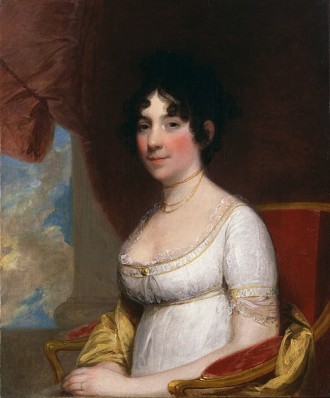Young Historian: Dolley Saves George
Young Historian: Dolley Saves George
August 12, 2024By Keli Holt

Paul Jennings, a man enslaved by President James Madison, was setting the dinner table at the President’s House (now called the White House) in Washington, D.C., on Aug. 24, 1814. Just as he filled the last goblet with wine, a rider galloped into the capital shouting, “Clear out! The general has ordered a retreat!” First Lady Dolley Madison, the wife of the president, heard the roar of cannons from the approaching battle and looked frantically around. Her gaze fell on the life-size portrait of George Washington, the nation’s first president. Not wanting this symbol of American independence to fall into the hands of the invading British Army, Jennings was ordered by the first lady to rip the portrait off the wall.
For the second time in 35 years, America was at war with Britain. The first was the American Revolutionary War (1776-1783) when America, led by Gen. George Washington, won independence from the British Empire. Even though Britain signed the Treaty of Paris that ended the war and guaranteed American independence, Britain often ignored the dictates of that treaty. Britain thus kept troops in forts on American soil, encouraged its Native American allies to fight American expansion, and refused to return American property seized during the war. While Britain lost its American colonies in 1783, the British Empire continued to expand elsewhere at that time, ruling Scotland, Ireland, Canada, parts of India and Germany, and many Caribbean islands.
Britain’s largest enemy immediately after American independence was not America but the French Empire. The French and British had been traditional enemies for several hundred years, and France had even helped America win independence from Britain. The assistance France gave America helped bankrupt France, leading to its own revolution in 1789.
The French Revolution threw Europe into chaos and sparked a series of wars that lasted for 25 years (1789-1815) between Britain and France. By 1800, the general/emperor Napoleon ruled France and attempted to conquer all of Europe. Britain was determined to stop him.
America remained neutral and maintained trade with all of Europe during these wars. However, the Napoleonic Wars were so expensive and mobilized so many men to fight that even the huge British and French empires started to run out of men and money. Both Britain and France thus began to capture American ships and seize the goods on them. Britain went even further than France and “impressed” Americans into its own navy. British officers would board an American ship, declare that some of its sailors were actually runaway Brits and force them into the British Navy.
The British policy of impressment outraged Americans. Britain also continued to impose unfair taxes on American ships trading with France and encouraged British Native American allies to resist American westward expansion. By 1812, Americans had had enough of British meddling and declared war. The goal was to remove the British from North America completely by kicking them out of Canada and the Pacific Northwest (the modern states of Oregon and Washington), which the British still claimed.
By 1814, the war was going badly for America. Twice, American armies invaded British Canada only to be repulsed because of incompetent generals and disobedient militia, local troops who refused to fight outside of their own states.
Luckily for America, the Napoleonic Wars were still raging in Europe, and Britain was unable to mobilize its entire military might to fight against the Americans. In 1814, however, there was a break in fighting in Europe, and battle-tested British troops sailed to America. On Aug. 24, 1814, this large force easily defeated the Americans at the Battle of Bladensburg just outside of Washington, D.C. With this defeat, the road to America’s capital city was wide open.
With dinner still sitting on the table at the President’s House, the order to evacuate the city came in. While most people had already fled D.C., First Lady Dolley Madison remained. She decided to save the famous portrait of George Washington. Jennings was ordered, with the help of a few others, to rip it off the wall. The frame holding the 8-foot tall painting had to be broken and the canvas removed by hand. Once the portrait was secure, Dolley escaped into a waiting carriage.
Moments later, the victorious British entered Washington, D.C. Entering the President’s House, the soldiers helped themselves to Madison’s dinner and wine. By that night, in revenge for the American burning of York (modern Toronto in Canada), the British set fire to almost every public building, including the President’s House. After a ferocious thunderstorm extinguished the fires overnight, the British restarted the fires, carefully burning the public buildings but not touching private homes and property.
The British remained in Washington, D.C., only one day before marching toward the strategic port of Baltimore. The successful American defense of Fort McHenry in Baltimore later inspired the words of our national anthem, “The Star Spangled Banner.”
Dolley and James Madison returned to the smoldering President’s House a few days after the British evacuated. The portrait of Washington was reinstalled in the President’s House in 1817 after it was rebuilt. The portrait still hangs today in a place of honor in the East Room of the White House. Painted in 1797 while George Washington still lived and America was a small, weak power in a world dominated by large empires, it now gazes over official White House ceremonies. Thanks to the quick thinking of Dolley Madison and her slave, Paul Jennings, a great symbol of American independence was preserved. Jennings remained enslaved by the Madisons for 20 more years before the Massachusetts senator and abolitionist Daniel Webster purchased him and freed him. Jennings went on to write the first White House memoir in 1865 about his time spent enslaved by Madisons. Dolley was not the only one who showed courage in the face of fire.





